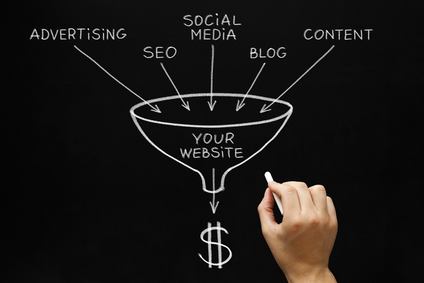Bear with me, I’m going to talk about a funnel, but maybe not the exact one you’re familiar with. I like fairs (with their funnel cakes) as much as the next guy, but what I’m referring to is a new twist on an old sales standby: the lead funnel. Let’s reimagine it as the digital marketing funnel.
There’s a simple slogan that can help contemporary marketers cover the entire buying cycle: Acquire, convert, nurture. No matter what stage a buyer is in, marketers responsible for helping to grow businesses can help create revenue by creating value.
Acquire
Let’s start with acquire. In order to sustainably grow new business, you need to find potential new customers out in the world. Bringing prospects to your website is the first step. Whether they come from search engines, social networks, or other referring sites, you need to first get their attention. Once you have their attention, you then need to get them to your website. This process can be likened to “filling the top of the funnel,” where new prospects begin the filtering that eventually turns them into leads/customers (conversions) or just window shoppers to be disqualified.
Convert
So, you have acquired some new Web visitors. If you want to convert them into leads or customers, you need to convince them that you A) have what they want/need and B) are trustworthy. Is your website welcoming them or repelling them? Is it making the information-gathering process easier or harder? They should be able to find resources that educate them about the given product/service, along with all the information they need to justify making a purchase (e.g., transparent pricing, accurate descriptions and credibility indicators like testimonials, 3rd-party logos, case studies and complete company bio information).
Nurture
What happens to the overwhelming majority of your visitors who are not ready to buy from you today? If you don’t nurture them, then how can you keep them from falling on the competitor side of the 70% who will eventually buy from you or a competitor? Keeping visitors engaged after they leave your site increases the chances they will come back to you when they are ready to purchase. Among the best ways to keep potential customers engaged is to offer them invaluable resources. By being memorable and building value in the relationship, you can remain connected and therefore eligible for their business down the road when (if) they are actually ready to purchase. Even if they don’t purchase, your nurturing might still leave a good enough impression that they would want to refer friends/colleagues who might be in the market for the same things they once were. New referrals and a reputation for being helpful can’t hurt, either.
Lead funnel vs. escalator
For another perspective on the funnel, consider the lead-to-advocate escalator from Forrester’s Lori Wizdo. Her metaphor suggests that marketers should proactively move buyers along the path to purchase on an individual basis, in contrast with the traditional sales funnel, which appears to not allow them to move through its stages with anything other than collective magic. Regardless of the metaphor, in today’s marketing world, you want to be aware of the buyer’s journey—and all the unique needs, wants and expectations that come with it.
———
Director of content marketing at Fathom, Paul is a 6-year veteran of the digital marketing industry who also has a teaching background. After spending many years serving clients as a Web copywriter, he currently leads Fathom’s internal content strategy in collaboration with the sales & marketing staff. He also serves as editorial director of Fathom’s website and blog and has written/edited multiple white papers on marketing. He previously was lead blogger and managing editor for YouShouldGoToSchool.com, a resource for individuals interested in career-focused education. Holding a BA in English from the College of Wooster, he is also the author of a collection of poetry, “Under the Lunar Neon.”
He is particularly interested in usability, readability, his niece/nephews, and playing tennis (not necessarily in that order).

